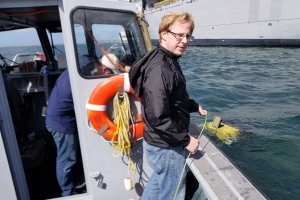Presented By: Michigan Robotics
Robotics PhD Defense: Josh Mangelson
Robust Multi-Agent Autonomous Underwater Inspection with Consistency and Global Optimality Guarantees

In manufacturing, teams of robotics systems, working in coordination with one another, have led to dramatic increases in safety, efficiency, and profit. Collaborative teams of robotic vehicles working together in unstructured environments have the potential to yield similar gains in a variety of application areas including automatic inspection of underwater structures. However, autonomous collaboration in real-world environments is significantly more difficult than in the factory. The main reason for this is because in an unstructured environment, fundamental information such as the position of the robotic agent, its relationship to other agents, and a model of the robot's surroundings all have to be estimated by the robotic vehicle online, while their estimation can be simplified or engineered out of the problem in a structured one. This is further complicated by the fact that in underwater environments, failure of a navigation or perception algorithm that estimates the above quantities can result in significant damage or the loss of a vehicle. Moreover, existing algorithms for navigation and mapping in unstructured environments, tend to fail in the presence of outlier measurements, when given a bad initialization, or when using an inaccurate characterization of pose uncertainty.
In this thesis, we propose four methods that bring us closer to robust and consistent multi-agent autonomous inspection. The first is a method for handling outlier measurements when merging maps generated by two agents collaboratively inspecting a structure. The proposed method uses graph theory to enforce that the selected set of measurements are consistent with one another resulting in more consistent maps than existing methods. The second is an initialization agnostic method for aligning robot trajectories based on low-dimensional data. The third is a way of formulating the simultaneous localization and mapping (SLAM) problem as a convex polynomial optimization problem. This enables us to guarantee that the trajectory estimated by the robotic vehicle is the true solution to the posed optimization problem. Finally, the fourth is method that uses Lie group theory and the Lie algebra to accurately characterize the uncertainty of jointly correlated poses. We evaluate the proposed methods and show that they outperform existing state-of-the-art algorithms.
We conclude with a discussion of "reliable autonomy" by describing a set of additional problems that need to be solved to enable reliable, large-scale, fully-autonomous, multi-agent inspection of underwater structures.
Joshua Mangelson is a Ph.D. Candidate in Robotics at the University of Michigan. His interests lie in the development of navigation, mapping, and perception algorithms that enable the design of reliable field robotic systems that can operate consistently in unstructured environments. He is especially interested in the development of large-scale multi-agent teams for autonomous inspection of underwater structures. He is the recipient of the IEEE ICRA Best Multi-Robot Paper Award and the IEEE OCEANS Best Poster Award both in 2018.
In this thesis, we propose four methods that bring us closer to robust and consistent multi-agent autonomous inspection. The first is a method for handling outlier measurements when merging maps generated by two agents collaboratively inspecting a structure. The proposed method uses graph theory to enforce that the selected set of measurements are consistent with one another resulting in more consistent maps than existing methods. The second is an initialization agnostic method for aligning robot trajectories based on low-dimensional data. The third is a way of formulating the simultaneous localization and mapping (SLAM) problem as a convex polynomial optimization problem. This enables us to guarantee that the trajectory estimated by the robotic vehicle is the true solution to the posed optimization problem. Finally, the fourth is method that uses Lie group theory and the Lie algebra to accurately characterize the uncertainty of jointly correlated poses. We evaluate the proposed methods and show that they outperform existing state-of-the-art algorithms.
We conclude with a discussion of "reliable autonomy" by describing a set of additional problems that need to be solved to enable reliable, large-scale, fully-autonomous, multi-agent inspection of underwater structures.
Joshua Mangelson is a Ph.D. Candidate in Robotics at the University of Michigan. His interests lie in the development of navigation, mapping, and perception algorithms that enable the design of reliable field robotic systems that can operate consistently in unstructured environments. He is especially interested in the development of large-scale multi-agent teams for autonomous inspection of underwater structures. He is the recipient of the IEEE ICRA Best Multi-Robot Paper Award and the IEEE OCEANS Best Poster Award both in 2018.
Explore Similar Events
-
Loading Similar Events...
